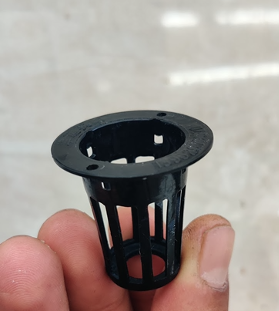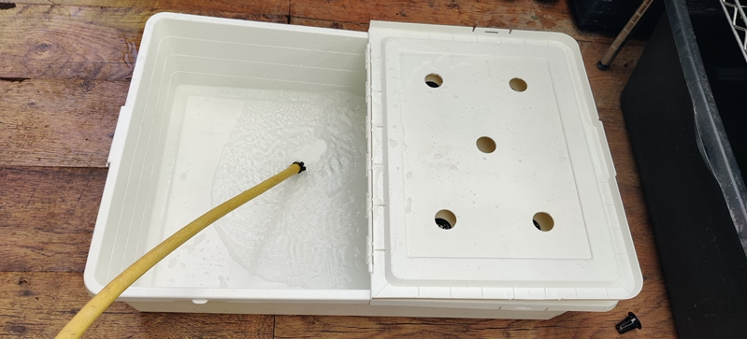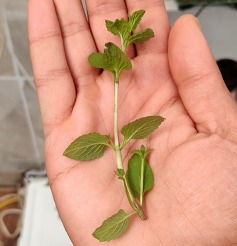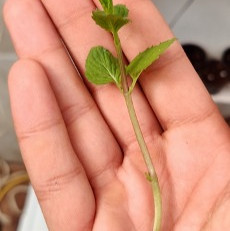How to build your own hydroponic system: a beginners guide
- Dish
- May 6, 2020
- 7 min read
Updated: Jan 28, 2021

Dish is Square Mile Farms’ Head Farmer. He’s spent the last year experimenting with growing 40+ types of vegetables, herbs and microgreens at our Paddington rooftop farm and in our office farm installations. Using his knowledge of building and maintaining indoor hydroponic systems he is on a mission to help London workers reconnect with their food by helping them grow it themselves!
Getting started with hydroponics
Are you interested in hydroponics or growing from home but don’t know where to start? Do you want to make your own system by up-cycling materials from your home? Growing hydroponically at home has lots of benefits: a regular supply of fresh, nutritious produce will certainly save you from making lots of trips to the supermarket!
There are a lot of different hydroponic systems, (check out my previous blog explaining them). In this blog we are going to cover the simplest one to understand. I’m going to explain how a Deep Water Culture hydroponic system works and how you can build one for yourself in no time at all.
What is the best hydroponic system for beginners?
Deep Water Culture (DWC) is the easiest type of hydroponic system that you can build and maintain at home. In this system, the plants grow with their roots submerged directly in nutrient-rich water. For home growers, this can be achieved by growing in large opaque storage containers or buckets. Commercial growers use rafts which float on a large bed of water; these work like a conveyor belt with young plants added on one side, they will move along until ready for harvest at the other side.
The lack of moving parts or recirculating water makes DWC systems relatively simple and cheap to build. The water in DWC systems does not recirculate, it remains sitting in the reservoir for the entire duration of the plant’s life. This means you must aerate the water to replenish oxygen that is used by the roots.
In soil, air pore spaces provide the much needed oxygen for roots and in recirculating hydroponic systems, water is aerated in the process of being pumped around. We can remedy this in a DWC system by using an air pump with an air stone attached (used in fish tanks) to ensure the water remains oxygen rich.
What can I grow in my DWC system?
The best crops to grow in DWC systems are Lettuce, Kale, Chard, Bok Choy, Basil and Parsley. These are all plants which are not too top-heavy. In DWC systems the roots are not well anchored and that means growing tall plants like tomatoes can be difficult, if you do grow them, you’ll need the right supports to keep the plant upright.
How to make a DWC hydroponic system at home
Materials: (scroll down for some product suggestions with links)
Storage container or bucket
Net pots
Airpump with air stone
Hard Water Liquid Nutrients (A & B)
pH Down
pH meter
Measuring beaker
Pipettes
Hole saw with arbor
Drill
Method:
1. Find a suitable container for the system
Many find that deeper storage containers and buckets work well for these systems because the deeper the reservoir of water, the more stable the nutrient solution will be. Fluctuations in nutrient concentration and pH are more likely in smaller reservoirs, you will also have to top up the water more regularly.
Light should not be able to penetrate your container, otherwise there is a high risk that algae will grow in your water. I used this 55l opaque storage container which we had leftover from a previous project. In retrospect, I would have preferred to use a deeper container but for my purposes of growing leafy greens this will work fine.
2. Drill holes into the lid of the container
The plants will grow in net pots, these are pots with plenty of holes for roots to grow through. The next step is to drill holes into the lid of the container where the net pots will sit. This requires the only specialist tool you’ll need in this build, a hole saw, these are quite affordable and easy to use. The size of net pots you use must be larger than the hole so they don’t fall through.
If you’re using a wider container like mine, you can drill multiple holes. It’s important to plan carefully here: I kept the holes 15cm apart to accommodate for the size of the mature plants. If you’re using a 20l bucket, I advise drilling one hole in the centre to make a single plant system (they’re great for growing something larger like tomatoes or courgettes).
Pro-Tip: Place some wood below your lid when you drill your holes, this will prevent the saw jolting and breaking the plastic.
3. Assemble your air pump
The air pump must remain outside of the reservoir. It will come with a check valve, this ensures that the pump does not suck water back up if it is turned off. If it does not come with one, you must keep the pump above the water level.
Connect the air stone and check valve with a length of tubing, ensuring the arrow on the check valve faces the air stone. Then connect the check valve to the air pump in the same manner.
4. Fill the reservoir, add nutrients and adjust the pH
The system can be quite heavy when full, so make sure you decide where your container will live before filling it up! Fill it almost full with water, leaving 1-2cm of space at the top.
Next you need to add your hydroponic nutrients to the water, following the instructions on your bottle. Mine advised me to add 2ml per litre of each A and B nutrients; using a measuring cup I added 110ml of each into my 55l container.
We also need to adjust the pH of the water. Using a pH meter, measure the pH; tap water will be anywhere from 6.5-7.5 pH. Most vegetables and herbs require a slightly acidic nutrient solution.
You can bring the pH down to 5.5-6.5 with drops of phosphoric acid using a pipette (commercially sold as ‘pH Down’ for hydroponic use). Wear gloves when handling pH down and remember to mix the solution well after application.
5. Assemble the system
Plug in the air pump and place the air stone in the reservoir. Secure the lid on top and you’re almost finished.
Adding your plants is simple, I placed some plants grown in rockwool plugs into the net pots. You can use seedlings grown in soil too but we advise using a medium that doesn't make a mess. Rockwool plugs or hydroton clay pellets are a cleaner solution.
How do I maintain my hydroponic system?
All done! Now for some maintenance must-dos.

It's very important to ensure the water level doesn’t drop too much, especially when the plants are young. As long as the water has sufficient contact with the roots they should grow well.
Keep an eye on the pH levels by checking it every time you top up water.
I use an old 2L water bottle to top up my water so I know exactly how much water I am adding. For every 2L of water I use, I add 4ml of each A & B nutrient into the reservoir.
Clean the reservoir and replace it with fresh water every 14-21 days.
Additional Tips
How to sow seeds directly into your DWC system
If you don’t have a way of propagating young seedlings, you can directly sow seeds so they germinate in the system.
To do this, place a rockwool plug into a net pot and place a seed or two into the plug. Ensure that the plug does not dry up at all or this could affect germination.
How to grow cuttings in your DWC system
You can also experiment with growing herb cuttings, I tried it with a mint cutting using a foam collar. It’s a sponge cylinder with a slit down the middle which you can wedge seedlings or cuttings into, I got mine free with the net pots.
I cut a mint stem under a leaf node, and then removed the bottom leaves and placed it into the foam collar and then net pot. Placing a bottomless plastic bottle over the cutting is advised to prevent it drying up.
Final thoughts
So that is how you can build a simple hydroponic system for yourself at home. You may already have some of the materials in your home right now, an old storage container or bucket can be repurposed in a worthy effort to start growing from home. If you don’t have a lid, you can cut holes out of a sheet of polystyrene packaging for plants to grow from.
When you’re first getting into hydroponics, the complexity of some of the systems on the market can be overwhelming. That’s why we recommend starting simple, a DWC system gives beginners an opportunity to do this. They are low maintenance and can be placed anywhere that has sufficient light, indoors or outdoors.
If you’d like to make a simple hydroponic system then give this method a try. Share your efforts with us on instagram or send us pictures of your new system to hello@squaremilefarms.com. And don’t forget, we’re here to help! Get in touch if you need some tips/advice on setting up your hydroponic system.
Square Mile Farms bring vertical, urban farming to city dwellers in their homes and in the workplace. We aim to bring people closer to food production and help to create a culture of healthy, sustainable living. Find out more about our offering for homes and offices and get in touch here with any queries. Sign up to our newsletter for tips on a healthy lifestyle and a round-up of relevant news. You can also follow us on social media to stay up to date with our journey, find us on Instagram, Twitter and Facebook. Why not join our online Urban Growing Community for advice on growing at home and much more!
Materials: product suggestions
.jpg)































